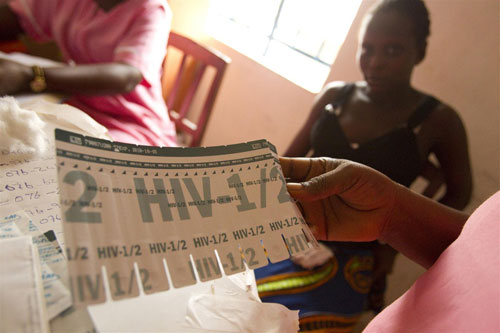Achieving an AIDS-free generation
Every day 1,000 children are newly infected with HIV, and every year thousands of children under five die from this preventable illness. UNICEF is working to achieve an AIDS-free generation by 2015—taking one more step toward reaching our goal of zero children dying from preventable causes. It is a big task, but with the cooperation of governments, NGOs, health clinics, and supporters like you, we can help every child reach their fifth birthday. Here are some of the most effective ways that UNICEF is using to help keep children safe from HIV/AIDS.
I remember when HIV/AIDS first entered our social conscience—it was a frightening illness. We have come a long way since then, and HIV/AIDS is no longer the death sentence it once was. Yet every year thousands of children under five die from this preventable illness. UNICEF is working to achieve an AIDS-free generation by 2015—taking one more step toward reaching our goal of zero children dying from preventable causes.

Sierra Leone, 2010. A maternal and child health aide prepares to administer an HIV-test during a prenatal consultation. © UNICEF/NYHQ2010-0989/Olivier Asselin
It is a big task, but with the cooperation of governments, NGOs, health clinics, and supporters like you, it is an attainable goal. Here are some of the most effective ways that UNICEF is using to help keep children safe from HIV/AIDS. Prevention of Mother-to-Child Transmission. Every day 1,000 children are newly infected with HIV—mostly from their mother during pregnancy, birth and breastfeeding. But by taking the correct medication a mother can prevent the virus from being transmitted in utero, and her baby can be born HIV free. In the developed world, HIV transmission from mother to child is almost completely eliminated. In developing countries, on the other hand, half of all pregnant women living with HIV do not receive the services needed to stop transmission of the virus to their babies. To prevent this type of transmission, pregnant women need to have access to HIV testing and, if HIV-positive, to treatment that protects their unborn baby. Prevention of HIV is a big factor in the fight against HIV/AIDS. By educating young people about HIV prevention, we can keep mothers from being infected in the first place. Treatment: If a baby is born with HIV or a child has tested positive, the right treatment at the right time can help children live with HIV/AIDS. Lastly, children are often orphaned by parents with AIDS, at which point they can lose protection and, among many other threats to their health and safety, increase their risk of getting HIV. Orphans need to be protected, for a parent's death can put the whole family at risk. In 2005, just 10% of women living with HIV received treatment to prevent their babies from being infected. Five years later, 50% of HIV-positive mothers were receiving treatment. We believe that by continuing our work, we can end children’s preventable deaths from HIV/AIDs and achieve an AIDS-free generation. Preventing HIV/AIDS in children is one way to help a child reach a fifth birthday. Join the Every Child Deserves a 5th Birthday campaign by uploading a photo of yourself at age five and help raise awareness about the millions of children who never get a chance to celebrate being five.


